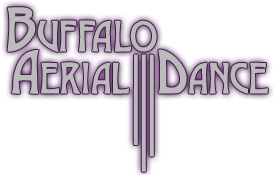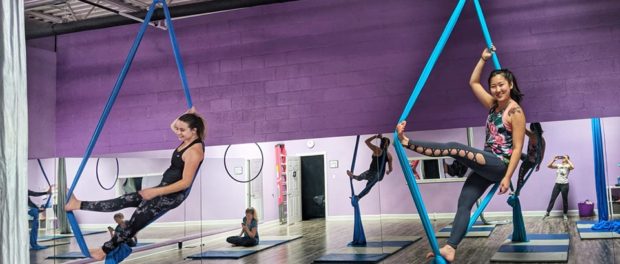You Only Get to be a Beginner Once (Also F.A.Q. page)
“You only get to be a beginner once,” is one of my most favorite things ever said to me by an aerial coach. Her point was that being a beginner is something to be enjoyed, not something to hurry past. One of the most frequently asked questions I get is “How long does it take to get 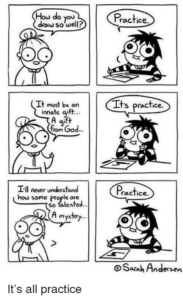 good?” which is exceptionally difficult to answer for a couple of reasons. First of all, I have no idea what you consider “good” and what I consider “good” comes in many forms. Second of all, people progress at very different rates. Never having met you, I have no idea how your unique body is going to function in the air. Third of all, even if we can establish the previous two points, I do not know how consistently you’re going to train. I can give you a very very very very rough average of a beginner student who comes to class at least once weekly as well as open gym at least once weekly is likely to be able to perform a Level 1 or Level 2 act in a student showcase after about 1 year — but we have fabulous students who have progressed more quickly and much more slowly than that, and that is fine!
good?” which is exceptionally difficult to answer for a couple of reasons. First of all, I have no idea what you consider “good” and what I consider “good” comes in many forms. Second of all, people progress at very different rates. Never having met you, I have no idea how your unique body is going to function in the air. Third of all, even if we can establish the previous two points, I do not know how consistently you’re going to train. I can give you a very very very very rough average of a beginner student who comes to class at least once weekly as well as open gym at least once weekly is likely to be able to perform a Level 1 or Level 2 act in a student showcase after about 1 year — but we have fabulous students who have progressed more quickly and much more slowly than that, and that is fine!
Often the first couple weeks or months of aerial training are delightful “Honeymoon.” Depending on your expectations, there can be some frustration too. I encourage you to let go of those insta-fueled expectations, but easier said than done, I know. But know this: if you are expecting to doing multiple flying flips right away, your teacher is going to break it to you that you’re starting with low footlocks like everybody else. And if you timidly walk in doubting that you can ever really learn aerial arts, you will find that your aerial teacher will insist that yes, you can get your butt up on that hoop!
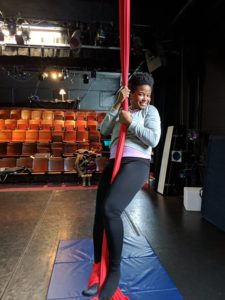
Standing in Footlock – a common move in your first aerial class
Those who can’t wait to start launching themselves through the air generally come from an athletic background. They ask: “I/my daughter/son have/has been doing gymnastics (or something similar) for X years, what class should I/they take?” The answer to this is simple. Everyone starts at Level 1. Those who have prior training related to aerial skills will progress faster. It is common for new students with experience in other physical activities to progress through level 1 tricks and start working on level 2 tricks in a month or two. However, there is more to aerial training than what tricks you can do with your body, so it’s important to start at the beginning to understand the language, artistry, and culture of aerial arts as you develop your skills!
As for those of you who are filled with self-doubt about your abilities, we hear you too! I get at least one, and sometimes multiple, inquiries a week asking “I’m really out of shape/overweight/too embarrassed to try this in front of others because what if I fail miserably. But is there any way I can still do this?” Yes, there is. If you are afraid of or uncomfortable with other people seeing you do something that you might not be great at right away, there are 2 things I’d love for you to know. One is that you can do private lessons and avoid ever having anyone witness your beginner-ness. If that is what makes you most comfortable, just ask! The other thing I’d like you to know is that EVERYONE who has ever tried aerial arts has had some embarrassing moments witnessed by others. If you can muster the confidence to take a group class, you will see other people in the class mess up, and it’s ok, it’s more than ok. It’s part of the experience, and we all cheer each other on.
As far as being out of shape or overweight, well, larger bodies are common and quite normal in our society, and we accept you for how you are! I don’t want to give you a line like “anyone can do it” but I certainly don’t want to assume that your larger size will prevent you from learning aerial arts! There is A LOT to say about this topic, and if you want to find more, try searching the Facebook group “Safety in Aerial Arts” for issues relating to weight. Here are some favorite insights on this issue from that group (some from students and some from coaches).
-
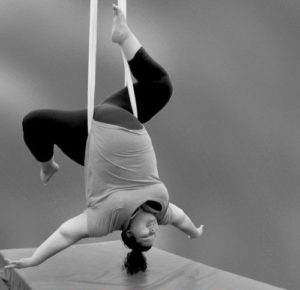
Celebrate the small victories!
“I have some larger bodied students that are in better shape than my thin newbies. I think it really depends on their background as weight is a very poor estimate of health and fitness. Of course, someone who has been inactive in recent history (or forever) and starts aerial will have a longer road to building strength because it’s harder to lift and coordinate 200 lbs than 100 lbs. I think that the same principles apply, starting at square one and likely taking longer to ramp up.”
- “As a plus size performer, and clocking in at 6ft1, I can tell you that it is really discouraging when you watch classmates zoom past you on things that should be ‘simple.’ With that being said, it really means a lot to celebrate the small victories.”
- “I’ve had some overweight students who weren’t able to do a lot, but still REALLY enjoyed the class…but I’ve had probably more who just seemed to be humiliated and really hard on themselves about not being able to do the basic moves.” (Please don’t be so hard on yourselves!!)
At B.A.D. we give modifications to any skills that we teach to make a version of the skill accessible to you. If a certain move isn’t working for you, be willing to work on the modified version and you’ll have a much better time, I promise. You will see improvements too, but it may take a little longer, that’s why celebrating the small victories is key. Here’s a short video of me teaching a move that’s accessible to most people — but there are modifications for this one too! Single Footlock from the ground
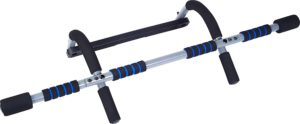
Here ya go!
It’s likely that at some point in your aerial training you’ll find that not seeing much progress towards that skill you really want to nail. Beginners, intermediate, and advanced aerialists alike all want to know: What can I do at home to improve my aerial skills? A few things that are generally recommended are pull-up bars, resistance band training, Pilates, weight training, and yoga. If you are working on something specific, you will need to break down that skill and condition the muscular actions that correspond to it, which might take research and/or help from a coach. There are also a number of great YouTube tutorial on aerial conditioning. Dr. Emily Scherb, aka The Circus Doc, has a fabulous YouTube channel, as well as other top-notch resources on what to do for your body to help it circus better!
Another common question is which apparatus should I start with? This one is 100% personal preference. You are welcome to try a class in the silks, the trapeze, and the lyra, and see if you have a favorite, or perhaps you’ll just love them all. There are qualities that make each apparatus fun and unique, and qualities that make each one difficult. The trapeze and the lyra are made with steel bars, which offer a nice base of support when you are in the air; they can be somewhat uncomfortable to beginners — but you get used to it pretty quickly. The silks take the most upper body strength from the beginning, but we will work with you on building that!
If you are having a hard time picturing what aerial apparatuses might look and feel like in action, that’s understandable. We often get asked: Is it possible to watch a class or see the studio prior to signing up? While we don’t want tons of observers in our classes for the comfort and privacy of our students, we do allow occasional observations. Another great option is to come by an open gym. This is practice time, and there is usually a coach around who can chat with you for a few minutes. Please shoot us an email or text before stopping by though! (buffaloaerialdance716@gmail.com or 716-432-8074)
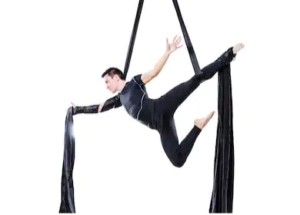
Men can fly too.
Another question we get pretty frequently is: can men/boys do aerial arts? Of course they can! We tend to be a majority female organization, but we do have a few male students, and men are welcome in any our classes, as well as boys in our youth classes. Those who choose not to identify as either male or female are welcome as well. There are tons of amazing aerial artists of all genders!
Last but certainly not least: What if I would like to begin aerial training, but have another limitation or concern that you didn’t mention? We do our best to accommodate your unique abilities. Please feel free to contact us if you have a specific concern such as a mental or physical disability or medical issue that may affect the way in which you perform physical activities. We will likely be able to accommodate you in some way, but please be aware that not all skills are appropriate for all people, and your aerial instructor may request that you do not do certain moves for your own safety (we will ask this of anyone who doesn’t have adequate preparation, not just the differently-abled). As mentioned above, we WILL always try to find a variation of a move that you CAN do. For inspiration, check out this story on an amazing amputee aerialist, read here.
